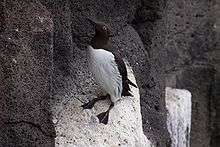Guillemot



Guillemots is the common name for several species of seabird in the auk family (part of the order Charadriiformes). In British use, the term comprises two genera: Uria and Cepphus. In North America the Uria species are called "murres" and only the Cepphus species are called "guillemots". This word of French origin apparently derives from a form of the name William, cf. French: Guillaume.[1]
The two living species of Uria, together with the razorbill, dovekie and the extinct great auk, make up the tribe Alcini. They have distinctly white bellies, thicker and longer bills than Cepphus, and form very dense colonies on cliffs during the reproductive season.
The three living species of Cepphus form a tribe of their own: Cepphini. They are smaller than the Uria species and have black bellies, rounder heads and bright red feet.
In July 2013, Dr Steven Portugal from the Royal Veterinary College demonstrated that when water touches the eggs, it forms into droplets rather than running off; in other words, guillemot eggs are water-repellant and self-cleaning.[2]
Systematics
Uria
- Common murre or common guillemot, Uria aalge
- Thick-billed murre or Brünnich's guillemot, Uria lomvia
Some prehistoric species are also known:
- Uria bordkorbi (Monterey or Sisquoc Late Miocene of Lompoc, USA)
- Uria affinis (Late Pleistocene of E USA)—possibly a subspecies of U. lomvia
- Uria paleohesperis
U. brodkorbi is the only known occurrence of the Alcini tribe in the temperate to subtropical Pacific, except for the very fringe of the range of U. aalge.
Cepphus
- Black guillemot or tystie, Cepphus grylle
- Pigeon guillemot, Cepphus columba
- Spectacled guillemot, Cepphus carbo
As in other genera of auks, fossils of prehistoric forms of Cepphus have been found:
- Cepphus olsoni (San Luis Rey River Late Miocene—Early Pliocene of W USA)
- Cepphus cf. columba (Lawrence Canyon Early Pliocene of W USA)
- Cepphus cf. grylle (San Diego Late Pliocene, W USA)
The latter two resemble the extant species, but because of the considerable distance in time or space from their current occurrence, they may represent distinct species.
References
- ↑ "Guillemot, n., etymology of" The Oxford English Dictionary. 2nd ed. 1989. OED Online. Oxford University Press. Accessed Dec 17, 2007
- ↑ Victoria Gill (5 July 2013). "Guillemot eggs are self-cleaning". BBC news. Retrieved 5 July 2013.